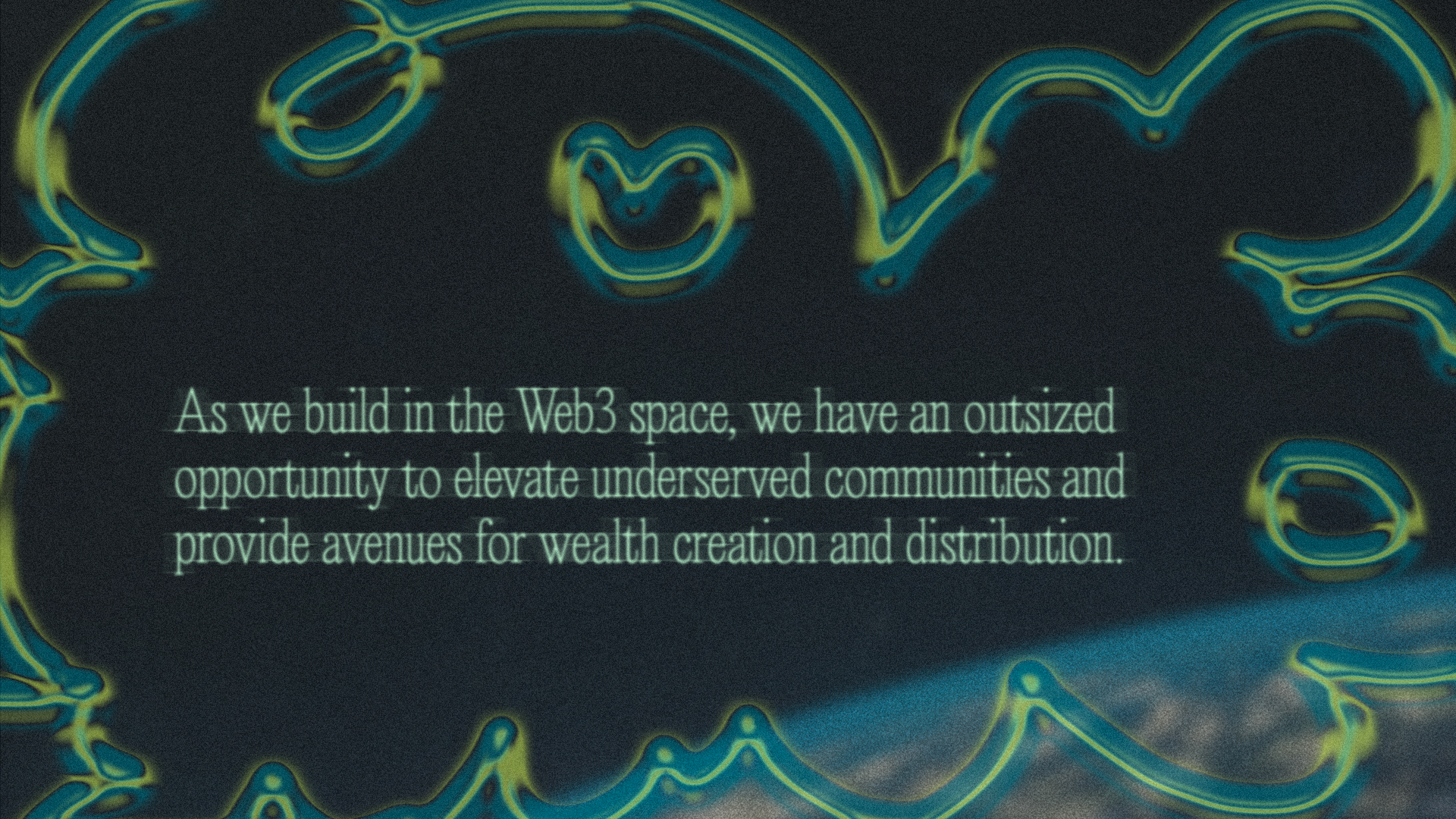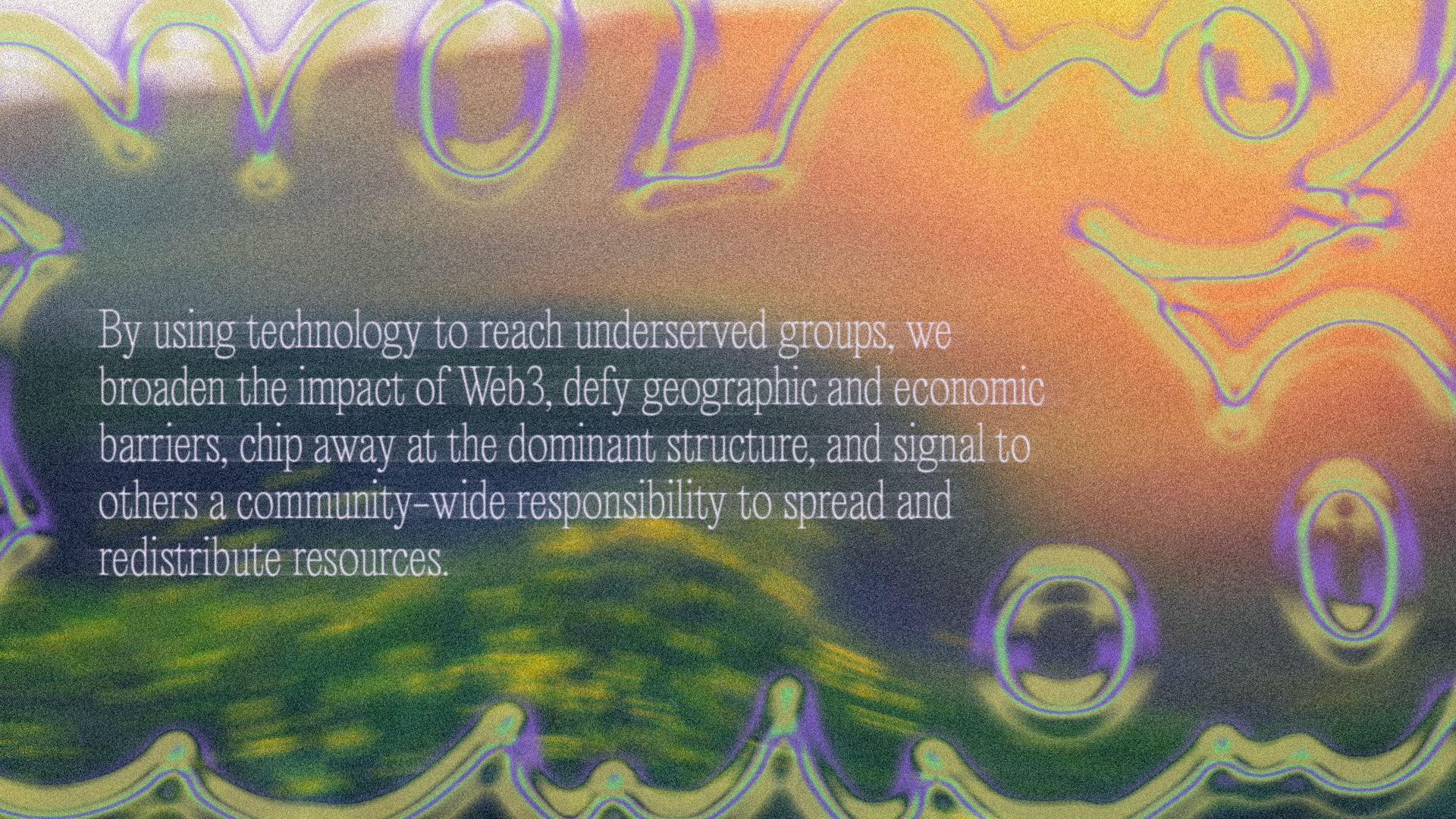- Aleph
- Anna Gat
- Ariel LeBeau
- Austin Robey
- David Blumenstein
- David Ehrlichman
- David Kerr
- Devon Moore
- Dexter Tortoriello
- Drew Coffman
- Drew Millard
- Eileen Isagon Skyers
- FWB Staff
- Gaby Goldberg
- Greg Bresnitz
- Greta Rainbow
- Ian Rogers
- Jessica Klein
- Jose Fernandez da Ponte
- Jose Mejia
- Kelani Nichole
- Kelsie Nabben
- Kevin Munger
- Khalila Douze
- Kinjal Shah
- Kyla Scanlon
- LUKSO
- Lindsay Howard
- Maelstrom
- Marc Moglen
- Marvin Lin
- Mary Carreon
- Matt Newberg
- Mike Pearl
- Mike Sunda (PUSH)
- Moyosore Briggs
- Nicole Froio
- Original Works
- Ruby Justice Thelot
- Ryne Saxe
- Simon Hudson
- Steph Alinsug
- The Blockchain Socialist
- Willa Köerner
- Yana Sosnovskaya
- Yancey Strickler
- iz

Sun Nov 14 2021
A study released by Gemini earlier this year found the average cryptocurrency owner is a 38-year-old male making approximately $111,000 a year. In addition, 74 percent of crypto holders are men, and 71 percent are white. And yet, many people in the Web3 community continue to evangelize a narrative of breaking down gatekeepers and scaling cryptography as a mechanism to build trustless networks that can benefit everyone.
Web3 evangelists discuss market freedom as a way to achieve maximum equality of opportunity when, in fact, on-chain market freedom continues to benefit those with education, financial means, risk tolerance, and resources. The crypto space has minted a new set of millionaires, but markets built without any regard for a varied set of circumstances across participants are likely to replicate existing inequalities—unless, that is, we invest in infrastructure that prevents this from happening.
As we build in the Web3 space, we have an outsized opportunity to elevate underserved communities and provide avenues for wealth creation and distribution, a goal that was never achievable through pre-existing models for the Internet. To ensure that resources are made available to those in need— rather than perpetuating structural inequality —we need to look for solutions in the following areas: Funding Mechanisms, Education, Onramps, and Web3 tooling. Below is a bit of what I have learned, based on my experiences as an investor and participant in the Web3 space.

Funding Mechanisms
To ensure greater inclusivity in crypto, we need to start with increased access to funding and capital for people of color, women, and LGBTQ individuals. Fortunately, there are already a number of initiatives making strides in this regard: In addition to projects like Gitcoin, which offer a way of funding public goods, dedicated programs like Uniswap’s XYK fellowship offer funding for a specific group of individuals. Investment DAOs like Komorebi and Audacity are investing in female, non-binary, and Black founders in Web3.
Crowdfunding is another powerful tool for generating support via capital. Recently, Ameer Suhayb Carter a.k.a. SIRSU and his gaming collective BLVKHVND expanded their group into a decentralized eSports community. In a Mirror crowdfund, they raised 338ETH (or over $1M) to execute this vision, funded by the community. Other exciting projects that have successfully used crowdfunding include Crypto Cookout, a community campaign to buy Black cryptopunks also spearheaded by SIRSU; Juicebox, which allows users to spin up a DAO in a matter of minutes; SharkDAO, which fractionalizes ownership of Nouns NFTs (and the governance power those NFTs afford in the Nouns DAO); and Pencil, which focuses on funding educational opportunities.
Education / Access
Knowledge and education are some of the most significant barriers to entry in crypto. The space moves lightning fast, and requires both baseline technical knowledge and the ability to approach problems from across disciplines.
“First, there is an issue of exposure and awareness,” says Medha Kothari, co-founder of she256, an organization dedicated to diversifying the blockchain space through broader accessibility and education. “A lot of our mentorship, community-building, and educational initiatives are aimed to increase the top of the funnel— getting more underrepresented [people] aware about crypto, its applications, [and] opportunities.”
While education is paramount, participation can yield even stronger results. Rabbithole, a site where users can earn crypto for participating in the digital economy and educating others, also embraces a top-of-the-funnel approach to understanding Web3. Through their pathfinders program and quests, users learn how to use different Web3 products and acquire skills they can use to help build Web3 projects— resulting in a growing community of actively engaged super-users. Additional projects, like Station and Layer3, are focused on onboarding users into DAOs; Women in Blockchain fosters community among female-identifying users.
Onramps
Financial barriers to entry are another issue. On Ethereum, gas costs are often too high for artists to mint NFTs. As a project gets popular, the cost of entry to its token-gated DAO rapidly rises.
There are a number of organizations already working to make Web3-accessible: Mintfund launched to help BIPOC and LGBTQIA+ artists mint their first NFT. Axie Scholarships offers a path for new players to dip their toe into the NFT-based online video game Axie Infinity. Fractionalization platforms like Party.bid, or initiatives like The Well, offer a path for collective purchases.
As more and more communities effectively become wealth-gated, it’s hard to imagine the problem going away anytime soon. But communities can do their part by exploring ways of onboarding members who may not be able to afford membership costs.

Web3 Tooling
Lastly, we can make crypto more inclusive by using Web3 tooling and innovative business models to benefit causes— and individuals —outside of our world. By using technology to reach underserved groups, we broaden the impact of Web3, defy geographic and economic barriers, chip away at the dominant structure, and signal to others a community-wide responsibility to spread and redistribute resources.
The opportunities here are limitless. Bail Bloc Project allows anyone to volunteer computational resources to mine crypto assets and raise money to get people out of jail. Corsali, an end-to-end machine learning platform, offers data-labeling employment to micro-entrepreneurs all over the world, offering streaming, real-time payments in the form of stablecoins. Play-to-Earn models, as employed by Axie Infinity, offer capital in exchange for economic in-game activity.
Axie recently crossed 1.7M users, a majority of whom are based in the Philippines; many of them are making several times their annual salary by playing the game. “It’s beautiful that we have been able to introduce crypto to people that have traditionally not been using it,” Jeff Zirlin, Axie Head of Growth, said in a recent interview. “We’re getting this technology in the hands of the people that really need it.”
Does everything have to be open?
The conclusion of these conversations is not that everyone should have access to every community. Reputation and effort play an important role in the creation of value, and therefore in wealth. However, the relationship between capital and labor is broken.
As builders in the Web3 space pave the way forward, it is imperative that they don’t replicate the inequalities of the Web2 world, and that they explore ways to build more equitable practices into the core of what they’re creating.
---
Kinjal Shah is an investor at Blockchain Capital and Komorebi Collective. She researches and writes about the intersection of consumer, culture, and Web3.
Graphics by Fiona Carty.


